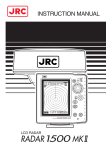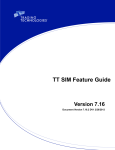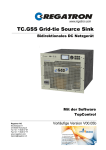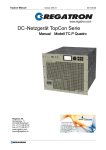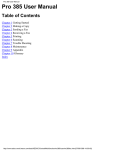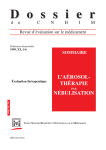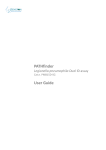Download Meningococcal Reference Unit user manual
Transcript
Health Protection Agency Meningococcal Reference Unit Part of HPA Respiratory and Systemic Infections Department (RSID) User Manual April 2012 MENINGOCOCCAL REFERENCE UNIT Edition no: 05 Issue date: April 2012 Page 1 of 26 Contains Information on References Services for: Neisseria meningitidis isolate characterisation Polysaccharide antigen detection Neisseria meningitidis (Meningococcal) DNA detection by PCR (Streptococcus pneumoniae detection by PCR) Vaccine response – (pre- and post- immunisation) Postal address Meningococcal Reference Unit Manchester Medical Microbiology Partnership PO Box 209 Clinical Sciences Building 2 Manchester Royal Infirmary, Oxford Road Manchester, UK M13 9WZ Hays address: DX 6962410 Manchester 90 M Telephone Fax Out-of-hours Telephone #44(0)161 276 6757 #44(0)161 276 5744 #44(0)161 276 1234 and ask for Medical Microbiologist on-call Authorised By: Dr E Kaczmarski (Head of Unit) Effective Date: April 2012 MENINGOCOCCAL REFERENCE UNIT Edition no: 05 Issue date: April 2012 Page 2 of 26 CONTENTS Introduction ................................................................................. 4 Summary of Services and Resources ......................................... 6 Services Available ....................................................................... 7 Key Factors affecting specimen performance ........................... 18 MRU Price List .......................................................................... 19 Specimen & Sample Submission Guidelines ............................ 20 Faxing and emailing reports containing patient's data .............. 23 Compliance with the Human Tissue Act ................................... 24 MRU Recognition of Caldicott Recommendations .................... 24 Key References......................................................................... 25 Charity and Public Information Contact Details ........................ 26 MENINGOCOCCAL REFERENCE UNIT Edition no: 05 Issue date: April 2012 Page 3 of 26 Meningococcal Reference Unit Introduction The HPA Meningococcal Reference Unit (MRU) for England and Wales has been situated in Manchester since 1978. Originally established to provide phenotypic characterisation of meningococci isolated in laboratories throughout the country, the nature and scope of this activity has widened as has the range of tests available. The MRU re-located from Withington Hospital, Manchester to Central Manchester Foundation Trust in March 2003 as an integral part of the Manchester Medical Microbiology Partnership (MMMP). The MRU is part of the Respiratory and Systemic Infections Department (RSID) and works closely with other parts of the HPA particularly the Immunisation Division and many other HPA colleagues in LARS to optimise meningococcal disease ascertainment through enhanced surveillance. The MRU has been a world leader in developing and making nationally available tests for non-culture case confirmation of meningococcal infection by PCR. Initially designed to identify the major disease causing serogroups (A, B, C, Y and W135), the test repertoire has been extended to provide more detailed additional characterisation utilising state of the art molecular techniques including DNA sequencing of genomic material from isolates and directly from clinical specimens where possible. The optimised surveillance, along with serological studies performed in the HPA Vaccine Evaluation Unit co-located within the MMMP at MRI were key elements in supporting and monitoring the successful introduction of meningococcal serogroup C conjugate vaccine in the UK and have contributed significantly to establishing the international reputation of the MRU. In addition to providing confirmatory laboratory services, staff from the MRU advise on investigation and management of individual cases and outbreaks. The MRU and CfI have been active in the recent establishment of a network of national and regional reference laboratories which are collaborating to harmonise and optimise surveillance throughout Europe and sharing this experience with other interested groups in the Americas and Oceania. This has resulted in the establishment of the European Meningococcal Disease Society (EMGM). MENINGOCOCCAL REFERENCE UNIT Edition no: 05 Issue date: April 2012 Page 4 of 26 MRU Contact Details General MRU Result enquiries Identification, phenotypic characterisation (serogroup, serotyping, subtyping), molecular characterisation (porA sequencing) and susceptibility testing of isolates Antigen detection PCR Requests for molecular epidemiology Initial contact for most MRU enquiries: Tel 0161 276 6757 Dr Stephen J Gray Lead BMS Tel: #44(0)161 276 6757 [email protected] Mr Anthony Carr, BMS2 [email protected] Dr Lynne Newbold, BMS2 [email protected] Medical Enquiries Patient investigation and clinical advice Interpretation of results Outbreak investigation and management advice Dr Edward Kaczmarski Head of MRU Tel: #44(0)161276 5699 Mobile: 07774243886 [email protected] Other Key Staff Vaccine evaluation, research and development Vaccine response assessment Proposed research projects PCR diagnosis of N. meningitidis Service and molecular research projects Professor Ray Borrow Deputy Unit Head of MRU Head of Vaccine Evaluation Unit (VEU) Tel: #44(0)161 276 6793 [email protected] Dr Malcolm Guiver Head of Molecular Diagnostics Tel: #44(0)161 276 8833 [email protected] Mr John Marsh Deputy Lead BMS Tel: #44(0)161 276 5685 [email protected] Database management Mr Richard Mallard Head of Laboratory Operations HPA North West Tel: #44(0)161 276 5747 [email protected] Other sources of information MENINGOCOCCAL REFERENCE UNIT Dr Mary Ramsay Consultant Epidemiologist Immunisation, Hepatitis and Blood Safety Department HPA Centre for Infections 61 Colindale Avenue, London, NW9 5EQ Tel: #44(0)20 8200 6868 E-mail: [email protected] Edition no: 05 Issue date: April 2012 Page 5 of 26 Summary of Services and Resources • Clinical advice for case and outbreak investigation and management • Meningococcal isolate confirmation and characterisation • Meningococcal DNA detection by PCR for non-culture case confirmation • Molecular characterisation of meningococcal isolates and non-culture (DNA positive only) material • Technical laboratory advice and support for large scale investigations • Meningococcal vaccine evaluation • Determination of response to meningococcal vaccination • Collection of >50,000 phenotypically characterised meningococcal isolates • Computerised database of laboratory confirmed cases • Collection of sera from laboratory proven cases of meningococcal disease • Support for collaborative scientific projects and audits MENINGOCOCCAL REFERENCE UNIT Edition no: 05 Issue date: April 2012 Page 6 of 26 Services Available Routine Investigations Neisseria meningitidis isolate characterisation Species confirmation Phenotypic confirmation of Neisseria meningitidis isolates based on morphology and biochemical reactions. Epidemiological characterisation of strains Phenotype: (a) Serogroup: identification of capsular polysaccharide antigens by serological reactions: coagglutination using polyclonal antibodies (in-house), commercial slide agglutination, commercial latex antigen kits and monoclonal antibodies. (b) Serotype: identification of class 2/3 (PorB) outer membrane proteins by a dotblot ELISA using monoclonal antibodies. (c) Sero-subtype: identification of class 1 (PorA) outer membrane proteins by a dotblot ELISA using monoclonal antibodies (supplied by HPA NIBSC) Genotype: (a) Serogroup: use of PCR based serogroup confirmation enables identification of non-viable organisms. (b) porA - Serosubtype – genetic characterisation of serosubtype by DNA sequencing. (Routinely tested and reported on all clinical isolates since October 2007). (c) Multi Locus Sequence Typing (MLST): performed and reported on strains collected for epidemiological monitoring and some outbreak investigation. Molecular subtyping of isolates Molecular characterisation of other potential typing targets such as fetA and fHbp (a component of newly developed vaccines) is undergoing evaluation. MENINGOCOCCAL REFERENCE UNIT Edition no: 05 Issue date: April 2012 Page 7 of 26 Antibiotic susceptibility testing Minimum Inhibitory concentrations (MICs): The MICs routinely determined on submitted isolates are: penicillin, cefotaxime, rifampicin, ciprofloxacin and sulphonamide (sulphamethoxazole) using Etest (Biomerieux) gradient diffusion methodology. Other antibiotic susceptibility tests may be performed on request. How to obtain MRU services Telephone contact For general enquiries: 0161 276 6757 The MRU laboratory is available Monday – Friday, 09:00 to 17:00 (often 08:30 – 17:30 dependent on staffing arrangements) If your call to the laboratory is not answered promptly, please telephone 0161 276 6757 as staff may be unable to stop a procedure or could be working in one of several other areas. Weekend enquiries For urgent clinical enquiries, particularly those occurring out of hours, weekends or on bank holidays please contact Dr Ed Kaczmarski on mobile contact available via the consultant medical microbiologist rota through Central Manchester Foundation Trust switchboard on 0161 276 1234. Out of hours specimens Specimens for PCR investigation must be received at the MRU by 10.00am weekdays to be tested the same working day. Arrangements to accept couriered urgent samples for PCR or other investigations must be agreed with the MRU before the samples are sent. Failure to do so may result in the specimen(s) not being tested in a timely fashion. Urgent couriered specimens should be addressed to “Microbiologist On-call” (if out –of hours) Meningococcal Reference Unit – URGENT SPECIMEN Manchester Medical Microbiology Partnership Clinical Sciences Building 2 Manchester Royal Infirmary Oxford Road Manchester M13 9WL If arriving after 5.30pm, Monday – Friday, at weekends, or on Bank Holidays, they should be left at the Manchester Royal Infirmary Accident and Emergency Department in the “On-Call Virology” box. MENINGOCOCCAL REFERENCE UNIT Edition no: 05 Issue date: April 2012 Page 8 of 26 Transport containers and documentation It is the responsibility of senders to comply with the current transport legislation and safety recommendations. Refer to http://www.dft.gov.uk/426155/425453/800_300/infectioussubstances.pdf for current guidelines. Complaints Should it be necessary to submit a formal complaint to the MRU about our service please contact either Dr Ed Kaczmarski or Dr Steve Gray. Turnaround times for isolate characterisation Optimal turnaround times are conditional on receiving established pure cultures with appropriate documentation Serogroup results for clinical isolates will be telephoned to the sending laboratory as soon as available – usually later on the day of receipt (Monday to Friday). The telephone report is logged but not printed. A ‘final report’ comprising the serogroup, and phenotypic characterisation (serotyping and serosubtyping) and antibiotic MIC profile are reported within 7 working days. Contact the MRU for urgent weekend reporting or if more rapid results are required e.g. for cluster investigation. The determination of molecular subtyping (porA sequencing variable regions VR1, VR2 and VR3) is reported when available (7 – 10 days) usually as an ‘additional report’. Urgent culture specimens In circumstances where urgent characterisation of an isolate is required, a provisional serogroup result can be available within two hours of receipt of an established culture. When additional information of epidemiological importance such as serotyping and serosubtyping is needed rapidly, a provisional phenotypic result can be available later the same working day if isolates are received before 10.00am, Monday to Friday. Arrangements to expedite urgent specimens should be made by telephone request to the MRU. This is particularly important if samples are likely to arrive at the MRU later than 17:00 Monday – Friday. Molecular subtyping (porA sequencing) requires a minimum of 3 working days from receipt. MENINGOCOCCAL REFERENCE UNIT Edition no: 05 Issue date: April 2012 Page 9 of 26 Meningococcal DNA detection by PCR The MRU uses real-time PCR (ABI Taqman™) assays to confirm N. meningitidis (meningococcal disease) and determine the infecting serogroup where possible. The MRU meningococcal (ctrA) screening assays are performed as part of a multiplex assay combined with a pneumolysin PCR for Streptococcus pneumoniae detection. Meningococcal detection by PCR The MRU uses real-time PCR (ABI Taqman™) assays to confirm N.meningitidis (meningococcal disease) and determine the infecting serogroup where possible. The MRU uses specific PCR assays to confirm the presence of N.meningitidis (and determine the genogroup, the potential serogroup) and also screens for the presence of pneumococcal DNA by two specific PCR assays (pneumolysin ply and autolysin lytA). The MRU meningococcal (ctrA) screening assay is performed as part of a fourcomponent multiplex assay also comprising: meningococcal serogroup B (siaDB) confirmatory assay, ply (pneumolysin) for Streptococcus pneumoniae screen and an inhouse Internal Control (IC) assay (process control). The ctrA PCR assay confirms the presence of N. meningitidis DNA, (specifically from capsulated meningococci as ctrA is involved in the transfer of polysaccharide to the cell surface). [The addition of another reverse ctrA primer to the originally published assay (Corless et al., 2001) since 2003 has allowed for the additional detection of a small subset of meningococci not confirmed by the initial assay – currently unpublished but data on file]. Specific serogroup confirmatory assays are based on the sialylation (siaD) of the polysaccharide capsule for serogroups: B, C, Y and W135. Serogroup A polysaccharide is chemically distinct and not sialylated hence the specific mynA assay. Charges Note: The HPA MRU meningococcal PCR assays are reference services for England and Wales epidemiology, and when performed are free of charge. The pneumococcal assays are currently free of charge as part of the HPA enhanced surveillance of pneumococcal disease post pneumococcal conjugate (Prevenar) vaccine introduction. As part of the enhanced surveillance programme of pneumococcal disease, pneumococcal DNA positive CSFs, bloods and empyema fluids from patients under the age of 16 are routinely referred to HPA Colindale (RSIL) for serotype confirmation. The pneumolysin PCR is also performed free of charge as part of the enhanced surveillance of pneumococcal disease post pneumococcal conjugate (Prevenar) vaccine introduction. Pneumolysin PCR positive samples are currently confirmed as Str pneumoniae by an additional autolysin PCR assay. As part of the enhanced surveillance, pneumococcal DNA positive blood and empyema MENINGOCOCCAL REFERENCE UNIT Edition no: 05 Issue date: April 2012 Page 10 of 26 fluids from patients under 16 years are referred to CfI for serotypying. What specimens to send for Meningococcal PCR MRU meningococcal PCR assays have been validated on EDTA (whole blood), CSF, coagulated whole blood, serum, plasma and joint fluids. EDTA whole blood and CSF are the preferred specimens. Plasma or serum can be examined howver sensitivity may be compromised If coagulated bloods are submitted it is only possible to test the serum fraction. EDTA blood (2.5 – 5 mL) sample collected on admission should be sent routinely to the MRU in the event that PCR confirmation is required. Smaller volumes (0.5 – 1mL) from infants and babies can also be examined. Heparinised or citrated samples can be tested, but EDTA is preferred CSF samples, if available, should be sent in addition to an EDTA blood sample. Definitive laboratory confirmation of meningococcal meningitis can only be made by analysis of a CSF sample. Other specimens from normally sterile sites may be examined after prior consultation with the MRU and a blood and/or CSF specimen should accompany them if available. The nucleic acid extraction processes are designed for fluid samples so there will be limited experience for unusual sample types. Positive results may be determined for such samples on the understanding that these should be considered “unvalidated” particularly with regards to negative results. Enhanced surveillance of pneumococcal disease has included the successful screening of empyema fluid and other respiratory samples by pneumolysin PCR. If tissue samples (or blocks) require examination they should only be submitted following specific consultation with MRU staff. They are not currently considered a routine investigation as they require bespoke manual processing with concomitant increases in turnaround time. Minimum volumes for PCR testing (DNA extraction): Blood or fluids - the routine use of automated nucleic acid extraction systems requires a minimum 400 µL of blood but a larger volume is preferred in case repeat testing is required. If smaller samples are submitted the fluid volume should be at least 100 µL. Small volumes require separate extraction and this will increase turnaround times. CSF - 400 µL or more is preferred but small samples (50 µL) can be tested. The small volumes require specific extraction and will likely increase turnaround times Low volume CSFs must be submitted in an appropriate sized container or tube. Whole CSF (i.e. an uncentrifuged specimen) should be sent in small sterile containers such as a sterile 2mL screw capped vial (rather than universal containers). MENINGOCOCCAL REFERENCE UNIT Edition no: 05 Issue date: April 2012 Page 11 of 26 Submission of minimum volumes is not preferred as repeat extraction is required to confirm positivity or the addition of molecular epidemiology assays. Original CSF (uncentrifuged) or re-suspended CSF deposits are preferred to CSF supernatants in order to increase sensitivity of detection. Collection and timing of samples for PCR testing: The likelihood of a positive PCR result decreases as the interval of sampling after starting antibiotics lengthens. Blood samples for PCR taken more than 48 hours after commencement of antibiotic therapy are unlikely to give useful results. CSF may remain “positive” for longer periods. Any specimens for PCR tests should be stored at 4oC and not frozen prior to transport. Freeze-thawing may reduce the likelihood of positivity with low genome copy samples and can result in cracked or broken containers. MENINGOCOCCAL REFERENCE UNIT Edition no: 05 Issue date: April 2012 Page 12 of 26 MRU PCR investigations performed Meningococcal and Pneumococcal PCR investigations All suitable submitted samples are tested using a four-component real-time (ABI Taqman™) multiplex assay comprising: the meningococcal specific screening ctrA assay (for capsulated N.meningitidis) , the meningococcal serogroup B (siaDB) confirmatory assay, ply (pneumolysin) for Streptococcus pneumoniae screen and an inhouse Internal Control (IC) assay (process control). Samples positive with the Internal Control (IC) assay are considered suitable for testing and reporting. The IC is added before nucleic acid extraction and assesses the sample for inhibitory qualities. Such as may occur with badly lysed blood samples or often with blood culture bottle fluids. (If DNA extracts and not clinical samples are submitted to the MRU the process control is not added and potential inhibition cannot be assessed). Meningococcal PCR Assays Samples positive with the ctrA PCR assay confirm the presence of N. meningitidis DNA, (from capsulated meningococci. To improve turnaround times, the simultaneous confirmation of serogroup B by siaDB PCR assay is used. Samples positive for ctrA but negative for siaDB are referred for specific serogroup C (siaDC), Y (siaDY) and W135 (siaDW) assays. If serogroup A is being considered (a vaery rare finding in the UK) a specific mynA assay is used. It should be noted that other serogroups such as X and 29E can cause invasive disease and are not currently confirmed molecularly by the HPA MRU. It is not uncommon for low level positives; i.e. samples with low numbers of genome copies (organisms) to be weakly positive with the sensitive ctrA screening assay but not confirmed with the specific siaD serogroup assays. Hence menoingococcal DNA may be detected but serogroup (genogroup) not determined. Very rarely non-capsulated (ctrA negative meningococci have been isolated from sterile sites and may be a cause of infection). Pneumococcal PCR assays The samples found positive with the pneumolysin PCR (ply) screen in the four component multiplex assay are referred for confirmation using a pneumococcal specific autolysin (lytA) PCR. Samples found to be positive with both ply and lytA are reported as Streptococcus pneumoniae or pneumococcal PCR positive. Samples that are only ply positive alone may indicate a streptococcal species, possibly an oral streptococcus species but are not reported as such. They are reported as pneumococcal PCR Negative. MENINGOCOCCAL REFERENCE UNIT Edition no: 05 Issue date: April 2012 Page 13 of 26 Positive pneumococcal reports from blood in children under 2 years of age It should be noted that there have been reports in the literature of pneumococcal DNA detected (PCR positive) in the blood samples of children under the age of 2 years who are perfectly well and healthy. It is for that reason that all positive pneumococcal reports from bloods of children less than two years of age recommend clinical interpretation of the molecular results. Hib PCRs An additional and separate PCR assay to detect Haemophilus influenzae type b is available on request. Other molecular detection assays Situated within the MMMP molecular diagnostics department the MRU is able to request a variety of additional PCR-based assays including viral causes of meningitis (eg., Herpes simplex, enterovirus). The additional assays are not part of the free meningococcal service but may be added to requests at the time of submission or later. Should only limited amounts of unrepeatable samples be available this may be a costeffective option. Nucleic acid extracts containing both DNA and RNA are available for rapid testing. Additional viral PCRs will be invoiced. If the additional viral PCRs are not requetsed on the original form it is necessary to provide the requesting clinician’s name at the time of the telephone request. MENINGOCOCCAL REFERENCE UNIT Edition no: 05 Issue date: April 2012 Page 14 of 26 Availability of results Results on specimens received up to 10.00 on Monday – Friday are normally available between 16:30 and 17:00 on the same day. Positive results will be telephoned following serogroup confirmation up to 17:30pm or as soon as possible on the morning of the next working day when printed reports will also be sent out. It is useful to telephone the MRU where a result is of particular urgency. NB: Although copy results are sent to the HPU it is the responsibility of the requesting laboratory to inform their local CCDC (HPU) of positive meningococcal PCR results in an appropriate timely fashion. Urgent PCR specimens These should be discussed with a member of the MRU staff, (who will liaise with colleagues performing the assays) and make arrangements for the earliest possible testing. Contact details will be required, especially any out-of-hours contact at the sending laboratory, relevant CCDC or HPU. Please do not send urgent samples likely to arrive out of hours without first discussing with MRU staff. Refer to ‘out of hours’ section on page 8. MENINGOCOCCAL REFERENCE UNIT Edition no: 05 Issue date: April 2012 Page 15 of 26 Antigen detection - non-culture confirmation Polysaccharide antigen detection Meningococcal antigen detection using commercial latex agglutination kits is available on request. Please discuss with a member of MRU staff before the sample is submitted. For acute investigations, PCR is preferred as it is more sensitive and if positive, additional molecular typing can be performed. NB: Antigen detection will reduce material available for PCR and could compromise the integrity of the sample. What specimens to send for polysaccharide antigen detection: CSF and serum – a minimum sample volume of 200µL is needed. Turnaround time Telephone reports are available on day of receipt. Printed reports normally sent out on the following working day. Urgent specimen These can be processed and results telephoned within two hours of receipt at the MRU. Please discuss with the MRU if urgent antigen tests are required. MENINGOCOCCAL REFERENCE UNIT Edition no: 05 Issue date: April 2012 Page 16 of 26 Meningococcal Serology (a) Serodiagnosis Serodiagnosis of meningococcal disease is not routinely available (b) . Pre- and post vaccine response The following services are available from the HPA Vaccine Evaluation Unit (VEU) based at the MMMP Functional, total immunoglobulin and isotype specific antibody levels for immunogenicity studies by internationally standardised assays are available. Samples of clotted blood or serum should be collected three to eight weeks post-vaccination. A minimum sample volume of 500µL is preferred. There will be a charge for these investigations unless they are part of an MRU or HPA instigated epidemiological investigation. 1. Quantitation of total IgG to serogroups C, Y, W135 or A polysaccharides. 2. Functional antibody to serogroup C, Y, W135 or A meningococci by internationally standardised serum bactericidal assays (SBAs). 3. Novel assays (bactericidal and ELISA) for other meningococcal serogroups, such as B are available on request. Charges Requests for vaccine response testing, if not initiated as part of an MRU or HPA epidemiological or case investigation, will be charged for. Turnaround Times Serogroup C vaccine response results are available within 28 working days of submission. MENINGOCOCCAL REFERENCE UNIT Edition no: 05 Issue date: April 2012 Page 17 of 26 Key factors affecting specimen performance What specimens to send All submitted samples must comply with the sample acceptance policy and be accompanied by a completed MRU request form which can be downloaded from the HPA website. Isolates for case confirmation, epidemiology and cluster management: 1. 2. 3. Please submit all available sterile site (CSF, blood and joint fluids) isolates from cases. If available, please submit throat and nose swab isolates from cases as well. Any isolates from case contacts (nose or throat swabs) should also be sent indicating which case they relate to. A complete case sample set could include; CSF, blood, joint fluid, nose and throat isolates. They are useful for molecular studies and validation of typing techniques. Other non-sterile sites: 1. 2. 3. Invasive respiratory samples (eg BALs), samples obtained by surgical procedure. Respiratory/sputum sample isolates if thought to be clinically significant N. meningitidis isolates with high MICs or unusual antibiograms Note: that approximately 30% of N. meningitidis isolates have penicillin MICs > 0.06 mg/L (BSAC breakpoint) and MICs up to 0.38 mg/L are not unusual Isolates with penicillin MICs > 0.5 mg/L are worth investigating further GenitoUrinary Medicine (GUM) isolates 1. Please do not submit routine GUM isolates Only submit isolates from GUM patients if they appear resistant (MICs of ≥ 0.25mg/L) or are epidemiologically linked to cases of invasive meningococcal infection. Other Neisseria species The MRU is established to confirm N. meningitidis and determine epidemiological markers. 1. The identification of Neisseria species other than N. meningitidis, N. lactamica and N. gonorrhoeae is problematic. Please do not submit isolates or organisms that are very unlikely to be N. meningitidis or lactamica. N. gonorrhoeae, other Neisseria spp and Moraxella spp should be referred to CfI. MENINGOCOCCAL REFERENCE UNIT Edition no: 05 Issue date: April 2012 Page 18 of 26 Turnaround Times and Price List Meningococcal Reference Unit, 2012/2013 price list Turn round time for Provisional result (working days) Turn round time to Final result (working days) Provisional results are telephoned within 24-72 hours Meningococcal cultures (outside England & Wales, where FOC) Meningococcal PCR (outside England & Wales, where FOC) Meningococcal serology - serum bactericidal assay - per target Meningococcal serogroup specific IgG Printed reports issued within 1-2 weeks 2 weeks 24 hours 48-72 hours 28 days 28 days 28 days 28 days Contact Mr Richard Mallard ([email protected]) for details of current prices. MENINGOCOCCAL REFERENCE UNIT Edition no: 05 Issue date: April 2012 Page 19 of 26 Specimen and Sample Submission Guidelines SPECIMEN ACCEPTANCE POLICY – GUIDANCE FOR LABORATORIES AND HEALTH PROTECTION UNITS LABELLING YOUR SPECIMENS MATTERS Specimens must be correctly labelled and request forms adequately completed. Minimise specimen rejection, confusion, delay by: Please follow these rules: Specimens MUST be labelled with the following: Surname Sender reference number PLUS any two out of three of the following: Forename Full Date of Birth NHS Number AND Date of Collection of Specimen Request forms MUST match the information on the sample PLUS Address for the report / requesting laboratory Patient address with postcode Consultant, GP, CsCDC Name of requestor Tests required Sender Reference Number Request forms SHOULD have Time and Date collected Sex Contact number for requestor Relevant clinical information Postcode If you have any problems/queries contact: Dr Steve Gray, BMS3, MRU: [email protected] Tel: 0161 276 6757 Fax: 0161 276 5744 MENINGOCOCCAL REFERENCE UNIT Edition no: 05 Issue date: April 2012 Page 20 of 26 Information required The MRU request form MUST be used whenever specimens are submitted. This can be downloaded from the HPA website at the following link: - http://www.hpa.org.uk/ProductsServices/InfectiousDiseases/LaboratoriesAndReferenceFacilities/ MeningococcalReferenceUnit/ Completion of the form ensures that the relevant investigations are carried out and reported back to sending laboratories with minimum delay. If important information is missing, sending laboratories may be contacted to supply details before testing is performed. Please see the MRU specimen acceptance policy on the previous page. It would be helpful if all requesting laboratories supplied their telephone and secure fax numbers (see page 21). The following information is important for accurate patient data reconciliation and assists provision of meaningful local statistics: date of birth; home post code; health district of residence. Isolates Please send cultures from all positive sites. For all isolates: ● Presenting clinical features i.e. meningitis, septicaemia, both (if other, please give details). Where relevant: ● Names of other possibly related cases. ● In contact tracing, the name of the index case and location (school/town etc). ● Recent travel details if there is a possibility of the disease being contracted abroad. Meningococcal PCR ● Type of specimen – EDTA / Heparin / Serum/ CSF ● Time elapsed since illness onset ● Whether and when parenteral antibiotics have been given in relation to sample collection MENINGOCOCCAL REFERENCE UNIT Edition no: 05 Issue date: April 2012 Page 21 of 26 How to send isolates – transport Only submit viable isolate samples in approved packaging (UN3373) which are suitable for Royal Mail post (airfreight) or commercial couriers such as HAYS DX. Agar slopes: where possible pure, viable cultures; inoculated on chocolate (heated) blood agar, blood agar or Dorset egg slopes after establishing growth by overnight incubation at 37oC. On occasion it may be necessary to submit an unincubated culture. This can save time but requires a heavy inoculum to ensure survival in transport. Please indicate on the request form if the material (slope) has not been incubated. Short-term storage of sloped cultures is optimal at 30oC if there are delays before submission. Non-viable cultures: cultures which are no longer viable may still be considered for characterisation by molecular based methods after consultation with the MRU. A heavy inoculum of the inert material on a slope may be submitted with an appropriate request form. Additional tests Additional tests can be requested by telephone or letter on samples received by the laboratory up to 2 months after the receipt of the sample, although it must be recognised that the archive sample available may have a limited volume. MENINGOCOCCAL REFERENCE UNIT Edition no: 05 Issue date: April 2012 Page 22 of 26 Faxing and emailing reports containing patients’ data The following guidelines are prepared having taken into account the Code of Practice on reporting patients’ results by fax prepared by the DoH and Caldicott recommendations. It is MMMP (MRU) policy that reports containing patients’ data, wherever possible, should not be sent by fax or e-mail. E-mails cannot be relied on to guarantee security of patients’ data because they can be intercepted by a third party on route, unless encryption is used. In exceptional circumstances it may be necessary to send a result by fax but not by email. In this case the following conditions must be adhered to after discussion with the laboratory. The patient’s name must be conveyed separately using a linking patient identifier. The report must be sent to a “safe-haven” fax machine. This means that, if the location is in general use, consideration must be given to ensuring that unauthorised personnel are unable to read reports, accidentally or otherwise. Also, the room housing the fax machine must be a secure location which is locked if it is likely to be unattended at the time the fax is sent. Assurance must be sought from the intended recipient of the faxed report, preferably in writing, that the receiving fax machine is a safe-haven. Measures must be taken to minimise the risk of mis-dialling, either by double-checking numbers or having frequently used numbers available on the fax machine’s memory dial facility. Confirmation must always be sought from the intended recipient that the fax is expected and has been received. MENINGOCOCCAL REFERENCE UNIT Edition no: 05 Issue date: April 2012 Page 23 of 26 Compliance with the Human Tissue Act – submitting samples from deceased people The MMMP / MRU adhere to the HTA and its application within the Central Manchester Foundation Trust site. Tissue samples (CSF, whole blood EDTA, blood, etc.) from patients are submitted to the MRU with their consent (obtained at time of sampling) for disease confirmation, epidemiological or public health investigations. Samples are tested and retained in accordance with the MRU specimen retention policy. Where, original samples (following nucleic acid extraction) are kept frozen for up to one year after receipt should sufficient remain following initial processing. Since 2006, post mortem samples or samples from the deceased (patients known by the MRU to have died) at the time of submission have been destroyed sensitively (or returned if requested). A minimal number of highly selected positive samples are retained for quality control, assay development s or epidemiological investigation under the local HTA guidance. Should it be necessary to contact the MRU regarding a HTA issue, the Person Designated (PD) is Professor Ray Borrow, tel: 0161 276 6793. MRU Recognition of Caldicott Recommendations The recommendations of the Caldicott Report (1997) have been adopted by the Health Protection agency as by the National Health Service as a whole. These recommendations relate to the security of patient identifying data (PID) and the uses to which they are put. MRU as an integral part of Manchester Medical Microbiology Partnership observes Caldicott guidance in handling PID. The MMMP has appointed its own Caldicott Guardian who advises on confidentiality issues and is responsible for monitoring the physical security of PID. This also applies to the transfer of results of investigations to and from MMMP whether by mail services, telephone or fax. The value of 'safe haven' arrangements or other means of the sender and receiver of information identifying themselves to each other before data are transferred is emphasized. MMMP is anxious to audit the security of its PID in collaboration with its customers. Customers are invited to review our arrangements in conjunction with the Caldicott Guardian. Customers are also asked to draw to the Caldicott Guardian's attention any instances where PID security has been threatened or has broken down. Uses that PID are put to outside clinical diagnostic services generally allow patient identifiers to have been removed before hand, and when PID is used for research purposes the proposals are considered first by the HPA Research Ethics Committee. All enquiries about the security and use of PID should be addressed to the Caldicott Guardian, Prof F J Bolton (Tel: 0161276 5699; e-mail [email protected]). MENINGOCOCCAL REFERENCE UNIT Edition no: 05 Issue date: April 2012 Page 24 of 26 Key References ● Kaczmarski EB, Cartwright KAV. Control of meningococcal disease: guidance for microbiologists. Comm Dis Rep Rev 1997; 5: R196-R198. ● Kaczmarski EB. Meningococcal disease in England and Wales: 1995. Comm Dis Rep Rev 1997; 7: R55-R59. ● Guiver M, Borrow R, Marsh J, Gray SJ, Kaczmarski EB, Howells D, Boseley P, Fox AJ. Evaluation of the Applied Biosystems automated Taqman polymerase chain reaction system for the detection of meningococcal DNA. FEMS Immunol Med Microbiol 2000; 28: 173-179. ● Guiver M and Borrow R. (2001) PCR diagnostics. In: Meningococcal Disease. Methods in Molecular Medicine (eds. Pollard AJ and Maiden MCJ) pp 23 – 39. Totowa, New Jersey. Humana Press, ● Gray SJ, Trotter CL, Ramsay ME, Guiver M, Fox AJ, Borrow R, Mallard RH and Kaczmarski EB. Epidemiology of meningococcal disease in England and Wales 1993/94 to 2003/04: contribution and experiences of the Meningococcal Reference Unit. J Med Microbiol 2006; 55: 887-896 ● Gray SJ, Borrow R, Kaczmarski EB. (2001) Meningococcal serology. In: Meningococcal Disease. Methods in Molecular Medicine (eds. Pollard AJ and Maiden MCJ) pp 61 – 87.. Humana Press, Totowa New Jersey. ● Borrow R, Carlone GM. (2001) Seogroup B and C serum bactericidal assays. In: Meningococcal Vaccines. Methods in Molecular Medicine (eds. Pollard AJ and Maiden MCJ) pp 289 – 308. Humana Press, Totowa, New Jersey. ● Corless CE, Guiver M, Borrow R, Edwards-Jones V, Fox AJ, Kaczmarski EB. Simultaneous detection of Neisseria meningitidis, Haemophilus influenzae, and Streptococcus pneumoniae in suspected cases of meningitis and septicemia using real-time PCR. J Clin Microbiol. 2001; 39:1553-8. ● Cartwright K. Meningococcal Disease. J Wiley & Sons 1995. ● Feavers IM, Fox AJ, Gray SJ, Jones DM and Maiden MC. Antigenic diversity of meningococcal outer membrane protein porA has implications for epidemiological analysis and vaccine design. Clin. Diagn. Lab. Immunol 1996; 3(4): 444-450. ● Jolley K, Urwin R, Suker J, and Gray SJ. 2006. Methods for meningococcal typing in Handbook of Meningococcal Disease: Infection, biology and Clinical Management. Editors M Frosch and MCJ Maiden. Chpt3; 37-51. Wiley-VCH, USA. ● Kuipers, B., van den Dopplesteen, G., Wedege, E. & van Alphen, L. 2001. Serological characterization. In Meningococcal Disease: methods and protocols. pp131-145. Edited by Pollard, A.J. & Maiden, M.C.J. Humana Press Inc., Totowa, New Jersey, USA ● Rosenqvist, E., Wedege, E., Hoiby, E.A. & Froholm, L.O. 1990. Serogroup determination of Neisseria meningitidis by whole-cell ELISA, dot-blotting and agglutination. APMIS 1990; 98: 501-506. ● Suker J, Feavers IM and Maiden MC. Monoclonal antibody recognition of members of the meningococcal P1.10 variable region family: implications for serological typing and vaccine design. Microbiology 1996; 142: 63-69. ● Wedege, E., Hoiby, E.A., Rosenqvist, E. & Froholm, L.O. Serotyping and serosubtyping of Neisseria meningitidis isolates by co-agglutination, dot-blotting and ELISA. J Med Microbiol 1990; 31: 195-201. MENINGOCOCCAL REFERENCE UNIT Edition no: 05 Issue date: April 2012 Page 25 of 26 Charities and Public Information Contact Details Meningitis Trust - Head Office Fern House Bath Road STROUD Gloucestershire GL5 3TJ United Kingdom 24 hour free phone helpline: 0800 028 18 28 Tel: +44 (0)1453 768000 Fax: + 44 (0)1453 768001 E-mail: [email protected] http://www.meningitis-trust.org Meningitis Research Foundation Midland Way Thornbury Bristol BS25 2BS Tel: +44 (0) 01454 281811 Fax: +44 (0) 01454 281094 Email: [email protected] http://www.meningitis.org/ Meningitis UK 25 Cleeve Wood Road Downend Bristol BS16 2SF Tel: +44 (0) 0117 373 73 73 Fax: +44 (0) 0117 373 73 74 Email: [email protected] Web: www.meningitisUK.org MENINGOCOCCAL REFERENCE UNIT Edition no: 05 Issue date: April 2012 Page 26 of 26



























